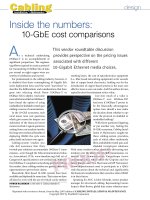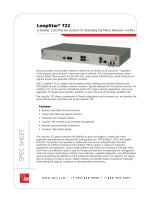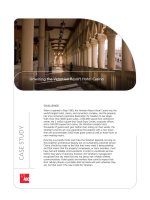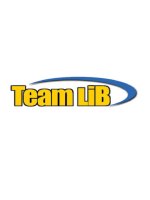Tài liệu Inside the numbers: 10-GbE cost comparisons pdf
Bạn đang xem bản rút gọn của tài liệu. Xem và tải ngay bản đầy đủ của tài liệu tại đây (409.47 KB, 3 trang )
design
A
s a technical undertaking,
10GBase-T is an accomplishment of
signifi cant proportions. e engineer-
ing eff orts required to create a protocol
for transmitting 10 billion bits of data
per second on eight copper wires are
worthy of celebration and marvel.
For professionals in the cabling industry, however, it
is doubtful that those contemplating 10-Gigabit Eth-
ernet deployment have used the word “marvelous” to
describe the deliberations and considerations that have
gone into selecting which flavor (10GBase-T or
10GBase-SX) to deploy. And some
users who have settled on 10GBase-T
have found the option of using
unshielded or shielded twisted-pair
cabling a source of consternation.
In the 10-GbE ecosystem, tech-
nical issues raise cost questions,
which give reason for deeper con-
sideration of the fi nancial invest-
ments involved. Logical questions
arising from cost analysis involve
the long-term technical benefi ts of
deploying 10GbE; the cycle com-
pletes itself and starts over again.
Cabling-system vendors pro-
vide full assurance that their
twisted-pair solutions accommodate 10GBase-T trans-
mission—even though the Telecommunications Indus-
try Association’s (TIA; www.tiaonline.org) full set of
Category 6A specifi cations is not yet fi nalized. With the
fi rst 10GBase-T-compliant networking products hitting
the market, these cabling vendors are getting their fi rst
opportunities to prove those claims.
Meanwhile, fi ber-based 10-GbE systems have been
available and deployed for some time. e truism we have
all heard is: even with the use of vertical-cavity surface-
emitting lasers, the cost of optoelectronics equipment
(i.e., fi ber-based networking equipment) so far exceeds
that of copper-based electronics, holding out for the
introduction of copper-based systems is the most cost-
eff ective move a user can make. And this author, for one,
typically takes that statement at face value.
Just how much of a value is
10GBase-T over 10GBase-SX?
And even if 10GBase-T proves to
be the fi nancially advantageous
option, how should a user make
the decision about whether to op-
erate the protocol on shielded or
unshielded cabling?
With those questions lingering,
or put another way, fueling the
10-GbE ecosystem, Cabling Instal-
lation & Maintenance sought out
three cabling-system providers,
each of which off ers multimode
fi ber, unshielded twisted-pair, and
shielded twisted-pair solutions.
With some vendors rather adamantly advocating one
medium over the others for 10-GbE transmission, we
invited ADC (www.adc.com); CommScope (www.
commscope.com), which off ers the Uniprise and Sys-
timax brands; and Tyco Electronics/AMP Netconnect
(www.ampnetconnect.com) to participate in a Q&A-
style discussion about the technical and, signifi cantly,
the fi nancial considerations that users face when 10GbE
is in their future.
Speaking for ADC is John Schmidt, senior product
manager for structured cabling. Representing Comm-
Scope is Matt Brown, global data center solutions man-
Inside the numbers:
10-GbE cost comparisons
This vendor roundtable discussion
provides perspective on the pricing issues
associated with different
10-Gigabit Ethernet media choices.
PATRICK M
C
LAUGHLIN
is chief editor of Cabling Installation &
Maintenance.
Reprinted with revisions to format, from the May 2007 edition of CABLING INSTALLATION & MAINTENANCE
Copyright 2007 by PennWell Corporation
PROOF!
shielded twisted-pair solutions. shielded twisted-pair solutions.
With some vendors rather adamantly advocating one With some vendors rather adamantly advocating one
PROOF!
try Association’s (TIA; www.tiaonline.org) full set of try Association’s (TIA; www.tiaonline.org) full set of
Category 6A specifi cations is not yet fi nalized. With the Category 6A specifi cations is not yet fi nalized. With the
fi rst 10GBase-T-compliant networking products hitting fi rst 10GBase-T-compliant networking products hitting
the market, these cabling vendors are getting their fi rstthe market, these cabling vendors are getting their fi rst
Meanwhile, fi ber-based 10-GbE systems have been Meanwhile, fi ber-based 10-GbE systems have been
medium over the others for 10-GbE transmission, wemedium over the others for 10-GbE transmission, we
invited ADC (www.adc.com); CommScope (www.invited ADC (www.adc.com); CommScope (www.
commscope.com), which off ers the Uniprise and Sys-commscope.com), which off ers the Uniprise and Sys-
timax brands; and Tyco Electronics/AMP Netconnect timax brands; and Tyco Electronics/AMP Netconnect
(www.ampnetconnect.com) to participate in a Q&A-(www.ampnetconnect.com) to participate in a Q&A-
ager. Brian Davis, global product manager, represents
Tyco Electronics.
(Note that in providing these individuals’ answers to
the questions posed, they had the option of answering
or not answering any question. Also, when more than
one individual answered a question the same or essen-
tially the same, Cabling Installation & Maintenance has
chosen to provide a single response.)
Q: On a “1x/1.5x/2x”-type basis, generally what are the
installed-cost fi gures for 100-meter, 4-connector channel
Category 6A UTP, Category 6A foiled/unshielded twist-
ed-pair (F/UTP), and laser-optimized 50-µm multimode
fi ber cabling systems?
Davis: Category 6A F/UTP and multimode fi ber are 1x; Cat-
egory 6A UTP is 1.1x.
Brown: Fiber-cable prices have remained stable during the
past few years, while copper raw material prices have driven
the cost of UTP and F/UTP cabling up. Based on UTP as 1x,
F/UTP installed links will be 1.15x, and laser-optimized fi ber
links will be 1.75x.
Q: Can you provide similar information about the cost of
1-Gig network equipment (network interface cards [NICs], LAN
cards), comparing 1000Base-T with 1000Base-SX?
Schmidt: According to Intel pricing, 1000Base-T NICs are
$145 while 1000Base-SX NICs are $510. And Cisco prices
1000Base-T small-form-pluggables (SFPs) at $315 while
1000Base-SX SFPs are $380. On the NIC side, 1000Base-SX will
be approximately 3.5 more expensive than 1000Base-T. Keep in
mind that 1000Base-T NIC ports have astronomically higher
volume than 1000Base-SX. For switch ports, which have higher
1000Base-SX volume, the cost is much closer, with 1000Base-SX
having only a 20% premium over 1000Base-T ports.
Brown: 1000Base-T and 1000Base-SX NICs have both fallen
dramatically over the past two years. ey are between 20%
and 35% of their 2005 price. e price gap between -T and -SX
has narrowed from 4x in 2005 to 3x today.
Q: Do you have any insight into what the market might expect,
in terms of a cost diff erence between -T and -SX, when a full com-
plement of 10GBase-T networking equipment is available?
Brown: Estimates at IEEE have historically predicted
10GBase-T prices will be 40% of 10GBase-SX prices. We
believe the biggest hurdle for 10GBase-T is the electronics
power requirement. e most effi cient NICs on the market
have power consumptions of <6 watts, while fi ber-based 10G
NICs are readily available between 2 and 4 watts.
Schmidt: Two NIC vendors, Tehuti Networks and Chelsio
Communications, have announced product. Chelsio’s 10GBase-T
NIC is priced at $1,995. Neterion’s 10GBase-CX4 NIC is $1,095,
while its 10GBase-SR NIC is $1,995 and its 10GBase-LR NIC is
$2,895. 10GBase-T NICs are currently about the same price as
10GBase-SR, as they have just been introduced and have low
volume. It is expected that by 2009 the relative cost between
10GBase-SR and 10GBase-T will be 4x, with 10GBase-T NICs
sub-$200 and 10GBase-SR around $800.
Q: Given the economics of optical networking, users may be
tempted to dismiss it out of hand for channels of 100-meter dis-
tances or less. But are there circumstances under which fi ber can
be the best overall choice in systems ≤100 meters?
Davis: ere are several reasons to deploy fi ber in horizon-
tal links less than 100 meters, including the following seven
scenarios:
1. Cabling runs through or is exposed to high radio-fre-
quency interference/electromagnetic interference (RFI/
EMI) noise areas;
2. Cabling runs through or is exposed to high-voltage
areas—there are no induced voltages on all-dielectric
fi ber cable;
3. Restricted pathway space, including but not limited to small
conduits, small bulkhead openings, and fi re barriers;
4. Cabling runs through or is exposed to high-temperature
areas;
5. 10-GbE-capable runs are needed today;
6. Secure areas with concerns about transmitted/radiated
signals;
7. Limited termination space for highest-density
connectivity.
Brown: Fiber has its strongest play when density is a major
concern, as in the storage area network (SAN) environment.
is relatively short-distance application is dominated by
fi ber cabling due to density concerns as well as the potential for
fi ber to upgrade to 100-gigabit and beyond. Fiber makes sense
below 100 meters when density and a clear upgrade path to
next-generation speeds are major concerns.
Schmidt: Absolutely. In particular, laser-optimized multi-
mode fi ber is an ideal medium for shorter-distance transmis-
sion for the following situations:
1. Fibre Channel transmission in SANs;
The size of a Category 6A cable, which can vary signifi cantly (as this
photo shows), is one of many considerations users must make when
choosing 10-Gigabit Ethernet media.
PROOF!
tempted to dismiss it out of hand for channels of 100-meter dis-tempted to dismiss it out of hand for channels of 100-meter dis-
PROOF!
According to Intel pricing, 1000Base-T NICs are According to Intel pricing, 1000Base-T NICs are
$145 while 1000Base-SX NICs are $510. And Cisco prices$145 while 1000Base-SX NICs are $510. And Cisco prices
1000Base-T small-form-pluggables (SFPs) at $315 while 1000Base-T small-form-pluggables (SFPs) at $315 while
1000Base-SX SFPs are $380. On the NIC side, 1000Base-SX will 1000Base-SX SFPs are $380. On the NIC side, 1000Base-SX will
be approximately 3.5 more expensive than 1000Base-T. Keep in be approximately 3.5 more expensive than 1000Base-T. Keep in
mind that 1000Base-T NIC ports have astronomically higher mind that 1000Base-T NIC ports have astronomically higher
tances or less. But are there circumstances under which fi ber can tances or less. But are there circumstances under which fi ber can
be the best overall choice in systems ≤100 meters?be the best overall choice in systems ≤100 meters?
Davis:Davis: ere are several reasons to deploy fi ber in horizon- ere are several reasons to deploy fi ber in horizon-
tal links less than 100 meters, including the following seven tal links less than 100 meters, including the following seven
scenarios:scenarios:
2. Highly secure network connections,
due to fi ber’s high degree of diffi culty
to tap or monitor;
3. Very high density network con-
nections that require small cable
diameters;
4. Sub-100-meter lengths that are
expected to be 100-Gigabit Ethernet
in the future.
It is expected that 100-Gigabit Ethernet
will have a 100-meter distance limitation
on laser-optimized multimode fi ber.
Q: When planning 10GBase-T-capa-
ble twisted-pair systems, end users face
complicated decisions about cable types
and those types’ characteristics. As-
suming we are talking about a 4-con-
nector channel in a “ friendly” environment (no excessive
external noise sources or extreme bends along the pathway), does
your organization recommend one medium over another?
Schmidt: Unshielded twisted-pair Augmented Category 6,
for the following reasons:
1. UTP Category 6A is available in the smallest diameter
that will support 10GBase-T—0.275 in. versus 0.285 in. in
F/UTP cables—which will improve conduit-fi ll ratios by
allowing more cables to fi t in a given-size conduit;
2. UTP Category 6A is the lowest-cost medium that will sup-
port 10GBase-T, accounting for all factors including compo-
nent cost, installation cost, troubleshooting, and testing;
3. UTP Category 6A is designed to meet and exceed all the elec-
trical requirements set forth by the IEEE, ISO, and TIA to
support 10GBase-T without resorting to shielding;
4. In 2006, more than 6.2 billion feet of category-rated cable
was installed in the United States; of that, less than 1.5%
was F/UTP, according to market-research fi rm BSRIA
(www.bsria.co.uk). As a result, there is very little instal-
lation, troubleshooting, and maintenance experience with
F/UTP cabling in the United States—precisely why the
vast majority will continue to use UTP cabling.
F/UTP and S/FTP cabling certainly has its place within the
network. It will provide superior external-noise suppression for
installations near high noise sources, such as radio or microwave
transmitters; however, standard noise from common sources,
and certainly alien crosstalk, can be more than adequately
eliminated by UTP Category 6A. So, for 98.5% of installations
in the United States, UTP cabling is going to be a more eco-
nomical choice that does not sacrifi ce performance.
Brown: We recommend TIA Category 6A, ISO Class E
A
-
compliant UTP cable. F/UTP solutions have several drawbacks
beyond their 15% price premium. When using UTP cabling,
the installer does not need to implement the additional bond-
ing and grounding steps that are required with F/UTP cables.
ere is additional time and cost associated with terminating
the shield and drain wire on F/UTP cabling. Due to the sen-
sitivity of this operation to installer technique, between 5%
and 20% of terminations need to be re-worked to properly
ground them. e possibility of the foil tape folding or kinking
can give F/UTP cables a larger bend radius than UTP cables. F/
UTP cables typically have 2-inch bend radii (similar to coaxial
cables), compared to typical UTP bend radii of one inch. Ease
of cable routing and dressing are critical in today’s dense con-
nectivity environments, such as the data center. While F/UTP
cables are smaller than some UTP cables, the density advantag-
es of F/UTP are small and do not justify the increased cost and
diffi culty of installation. If density is a critical concern, then fi -
ber is preferred.
Davis: For 10GBase-T-capable twisted-pair systems, Tyco
Electronics recommends a Category 6A F/UTP system. From
a performance perspective, shielded technology eliminates
the eff ects of alien crosstalk—the most dominant and critical
additional parameter for 10GBase-T. From an installation
point of view our jack greatly simplifi es installation and
ensures consistent high-performance terminations. is jack
is designed to handle heavier-gauge conductors and makes it
easy to maintain pair twist—even with the tighter pair twist
of Category 6A cables. ere is no need to fi eld-test a shielded
installation for alien crosstalk, whereas an unshielded solution
requires hours of additional testing for 100% coverage, or a
“sampling” test procedure, which reduces the time investment
by sacrifi cing 100% verifi cation.
Cost model lets you make your own calculations
T
he TIA’s Fiber Optics LAN Section
(FOLS; www.fols.org) provides on its
Web site a cost model that lets users
compare the costs associated with
deploying the cabling infrastructure
and network hardware for protocols, in-
cluding Gigabit and 10-Gigabit Ethernet.
Cost-model users must register before
beginning, but the registration and use
of the model is free. FOLS has updated
the pricing data in its cost model periodi-
cally, and the model lets users input their
own numbers as well. The participants in
this article—ADC, CommScope, and Tyco
Electronics—are all FOLS members.
“FOLS continues to be committed to
keeping our cost model current,” said
Andrew Oliviero, FOLS chair, when the
model was most recently updated in Feb-
ruary. “For this update, we made changes
that will make it easier for users to make
accurate comparisons among archi-
tectures, essentially updating the data
without making signifi cant changes to
the structure of the model.” The newest
updates include new media choices,
aggregate pricing refl ecting current mar-
ket conditions, the ability to customize
port-utilization calculations, and a graphic
comparison of different architectures.
nent cost, installation cost, troubleshooting, and testing;nent cost, installation cost, troubleshooting, and testing;
3. UTP Category 6A is designed to meet and exceed all the elec-3. UTP Category 6A is designed to meet and exceed all the elec-
trical requirements set forth by the IEEE, ISO, and TIA to trical requirements set forth by the IEEE, ISO, and TIA to
support 10GBase-T without resorting to shielding;support 10GBase-T without resorting to shielding;
4. In 2006, more than 6.2 billion feet of category-rated cable 4. In 2006, more than 6.2 billion feet of category-rated cable
was installed in the United States; of that, less than 1.5% was installed in the United States; of that, less than 1.5%
was F/UTP, according to market-research fi rm BSRIA was F/UTP, according to market-research fi rm BSRIA
UTP cables typically have 2-inch bend radii (similar to coaxial UTP cables typically have 2-inch bend radii (similar to coaxial
cables), compared to typical UTP bend radii of one inch. Ease cables), compared to typical UTP bend radii of one inch. Ease
of cable routing and dressing are critical in today’s dense con-of cable routing and dressing are critical in today’s dense con-
nectivity environments, such as the data center. While F/UTPnectivity environments, such as the data center. While F/UTP
cables are smaller than some UTP cables, the density advantag-cables are smaller than some UTP cables, the density advantag-
es of F/UTP are small and do not justify the increased cost and es of F/UTP are small and do not justify the increased cost and


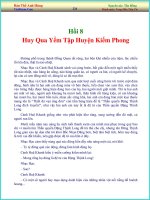

![Tài liệu Beginning the Linux Command Line [Apress 2009] ppt](https://media.store123doc.com/images/document/13/ce/kn/medium_zPbk2szWHh.jpg)
